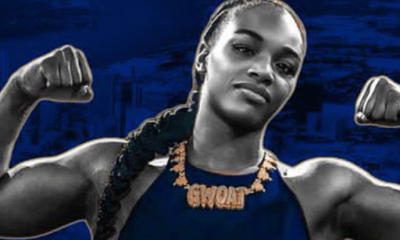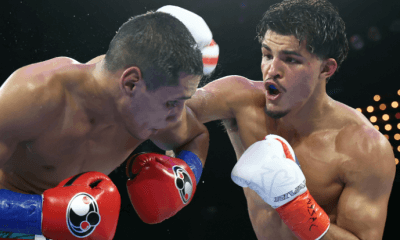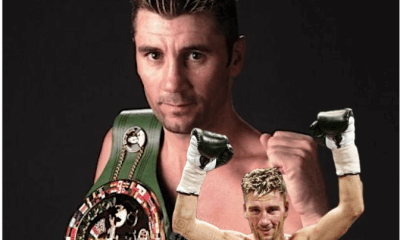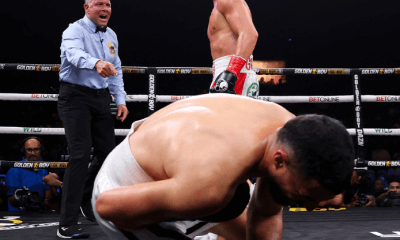Featured Articles
Bobby Goodman (1939-2023): An Appreciation
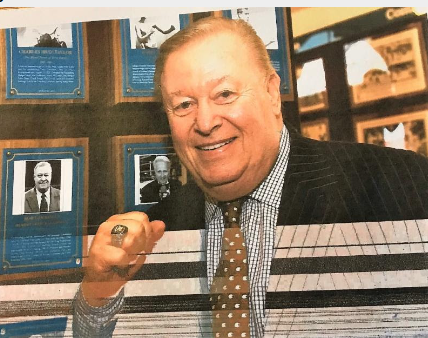
Bobby Goodman died on Sunday, March 5, at age 83. That’s a loss for boxing.
Goodman’s family personified the American immigrant experience of an earlier time. Moses Golubitsky was born in Tsarist Russia and began the voyage to America with his parents at age eight. His father died at sea of pneumonia. His mother opened a restaurant in the living room of their home to support her family in the new world. Moses Gubitsky’s name was changed to Murray Goodman. As a teenager, he worked as an office boy. By the time he was twenty-one, he was sports editor for the Hearst wire service. Eventually, Madison Square Garden hired him as a publicist. Soon, he was MSG’s director of public relations. Eventually, he opened a public relations agency of his own.
Bobby (Murray’s son) was born in the Bronx in 1939. In that era, when fighters went to training camp for a big fight, newspaper men (there were no newspaper women in boxing) went with them.
“My father would coordinate both camps,” Bobby later reminisced. “So I grew up in boxing. Boxing is in my blood. I was literally conceived in a training camp at Grossinger’s.”
Bobby spent his childhood in camps with the likes of Joe Louis and Sugar Ray Robinson. “I remember Rocky Marciano playing ball with me,” he recalled. “I’d pitch; he’d catch. We had imaginary batters and he called balls and strikes. Except one day, Charlie Goldman [Marciano’s trainer] saw us and shouted at me, ‘Bobby Goodman; what the f*** are you doing? That ain’t a little league catcher. He’s the heavyweight champion of the world.'”
As Bobby grew older, he helped his father with PR during the day and worked in a bar at night. Then he began working fulltime with his father, handling publicity for most of the big closed-circuit fights of that era.
On October 30, 1974, Muhammad Ali knocked out George Foreman in the eighth round of their heavyweight championship fight in Zaire. A lot has been written since then about Ali’s “rope-a-dope” strategy and whether the ring ropes were loosened that night to accommodate him. Bobby answered that question for me.
“Before any fight,” Bobby recounted when I interviewed him while researching Muhammad Ali: His Life and Times, “Angelo [Dundee] would go down to check the ring and make sure it was all right. In Zaire, the fight was at four in the morning, so we went at noon the day before. And the ring was awful. It was brand new but it hadn’t been set up right. One corner was sinking into the mud, so we had to put concrete slabs under the cornerpost. The padding was Ensaflor, which is the universally approved safety flooring. It’s a foam rubber that provides maximum safety for the boxer if he hits his head, but it has to be kept in a cool environment. Once you put Ensaflor in heat and humidity, like any foam rubber, it gets soft and mushy. We’d asked the ring crew not to put it down until the evening of the fight, but they’d put it down early. That meant the ring would be slow, which was definitely to Ali’s disadvantage. The canvas was new and much too slippery, so we put some resin on it. Then some guy came along with a bucket and sponge, trying to wipe the ring clean. Angelo asked, ‘What are you doing?’ And the guy answered, ‘The television people told us the ring was dirty.’ Angelo said, ‘That’s not dirt, that’s resin. You gotta put resin in the ring.’
“So all those things were going on,” Bobby continued. “But the worst problem was the ropes. New ropes stretch after one night’s use. They have to be readjusted because they become loose. And because these ropes were new and had been left out in heat and humidity, they’d already started to stretch. Plus, to make matters worse, you can tighten ropes by turning the turnbuckles in each corner. But here, the workmen had already tightened the turnbuckles as far as they’d go. So we had to readjust the ropes. We didn’t loosen them. We made them tighter. If we hadn’t, with the heat and humidity and preliminary bouts, by fight time they would have been draped on the floor. The way we did it was, we took off the clamps, pulled the ropes through the turnbuckles, lined everything up, and cut off the slack. We took about a foot out of each rope, and retightened the turnbuckles by hand so they could be tightened more just before the fight. Angelo even told the ring chief that, right before the first bout, he should tighten the ropes by turning the turnbuckle. And then, before the main event, they were supposed to tighten them again. That never happened. They just didn’t do it. So by the time Ali got in the ring, the ropes were slack. But there was nothing underhanded in what Angelo did. In fact, Dick Sadler and Archie Moore, who were Foreman’s cornermen, saw us that afternoon in the ring. Angelo and I were sweating our butts off, cutting the ropes with a double-edged razor blade because nobody could find a knife. We were pulling them through, taping up the ends. And we said, ‘Come on! You know, you guys can help.’ But it was hot, and they wouldn’t give us a hand.”
Bobby later spent twenty-five years with Don King Productions in capacities that ranged from director of public relations to matchmaker to oversight of all boxing operations. He was a senior vice president and head of boxing for Madison Square Garden for almost a decade. At one point, he set up his own promotional company.
Wherever he went, Bobby was a team player. On fight nights with chaos all around him, he was a calm steadying presence in the eye of the storm. During his career, he was honored by the Boxing Writers Association of America with the “James J. Walker Award for Long and Meritorious Service to Boxing” and inducted into the International Boxing Hall of Fame.
Bobby and his wife were married for more than a half-century. They had four daughters and nine grandchildren. Kathy died several years ago. It was a horrible blow.
“I always figured I’d go first,” Bobby told me. “I feel lost without her.”
His own health soon suffered a marked decline.
Bobby loved boxing. “I believe in boxing,” he said one day over lunch when we were talking about his sojourn through the sweet science. “Boxing has been my life; not just not my job. I like to think that I’ve been good for the sport; that I’ve never hurt anyone or done anything to hurt boxing.” Then he added, “There’s nothing I’ve ever wanted to do but be in boxing. I still get goosebumps when the lights go down and the ring announcer says, ‘Ladies and gentlemen; for the heavyweight championship of the world.’ I’m a very lucky guy. If I had to live my life all over again, I’d live it the same damn way.”
I’ll miss Bobby. He was part of an ever-dwindling group of people – men like Bruce Trampler, Don Elbaum, Don Majeski, Ron Katz, and Russell Peltz – who got into boxing young, loved it, understood it, stayed with it, and helped keep its traditions alive.
“Losing Bobby hurts,” Russell Peltz says. “As time goes by, the number of people who were in the trenches and remember boxing the way it was and understand how great a sport it can be keeps getting smaller. So many people now; when you mention boxing, they think of boxing the way it is today. They don’t understand what a champion is. They don’t understand the best fighting the best. Boxing just lost a piece of its past.”
And its future.
Thomas Hauser’s email address is thomashauserwriter@gmail.com. His most recent book – In the Inner Sanctum: Behind the Scenes at Big Fights – was published by the University of Arkansas Press. In 2004, the Boxing Writers Association of America honored Hauser with the Nat Fleischer Award for career excellence in boxing journalism. In 2019, Hauser was selected for boxing’s highest honor – induction into the International Boxing Hall of Fame.
To comment on this story in the Fight Forum CLICK HERE
-

 Featured Articles3 weeks ago
Featured Articles3 weeks agoResults and Recaps from New York Where Taylor Edged Serrano Once Again
-

 Featured Articles3 days ago
Featured Articles3 days agoThe Hauser Report: Zayas-Garcia, Pacquiao, Usyk, and the NYSAC
-

 Featured Articles2 weeks ago
Featured Articles2 weeks agoResults and Recaps from NYC where Hamzah Sheeraz was Spectacular
-

 Featured Articles3 weeks ago
Featured Articles3 weeks agoFrom a Sympathetic Figure to a Pariah: The Travails of Julio Cesar Chavez Jr
-

 Featured Articles3 weeks ago
Featured Articles3 weeks agoPhiladelphia Welterweight Gil Turner, a Phenom, Now Rests in an Unmarked Grave
-

 Featured Articles1 week ago
Featured Articles1 week agoManny Pacquiao and Mario Barrios Fight to a Draw; Fundora stops Tim Tszyu
-

 Featured Articles1 week ago
Featured Articles1 week agoArne’s Almanac: Pacquiao-Barrios Redux
-

 Featured Articles4 weeks ago
Featured Articles4 weeks agoCatterall vs Eubank Ends Prematurely; Catterall Wins a Technical Decision




